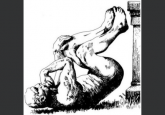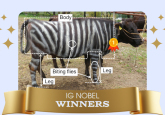Introducing the winners of the 2024 Ig Nobel Prizes

The Ig Nobel Prizes find the fun in science, awarding those research endeavors that comically contribute to our understanding of the world in areas such as botany, medicine, biology and chemistry. From discovering that mammals are capable of breathing through their anus to the way peoples’ hair swirls depending on which hemisphere they’re from, this year’s winning research certainly doesn’t disappoint.
Make your paper airplane, grab a comfortable seat and get ready to laugh, and then think, while we introduce the 34th First Annual Ig Nobel Prize winners.
Taking stock of bottom breathers
Looking to address the challenges of ventilating patients that arose during the COVID-19 pandemic, Takanori Takebe (Tokyo Medical and Dental University, Japan) looked to an unlikely source for inspiration; instead of improving traditional ventilation approaches utilizing the respiratory pathway, why not look for a new pathway altogether?
Inspired by aquatic organisms such as loaches, which breathe through their intestines, Takebe set out to determine whether mammals were capable of a similar feat. The team tested two methods of enteral ventilation via anus (EVA), one utilizing intra-rectal oxygen O2 gas ventilation (g-EVA) and the other using liquid oxygenated perfluorocarbon (l-EVA), in mouse and pig models of respiratory failure.
Both methods were found to rescue the test subjects, improving survival and systemic O2 concentrations. An enema-style l-EVA procedure was preclinically validated as safe and repeatable in a rat model, ultimately demonstrating that an anally administered ventilation procedure could be a viable option to treat challenging respiratory conditions and earning Takebe the physiology prize.
Just an average Friday night for the worms…
Worms can get drunk. But how would you know? Forget the breathalyzer, Tess Heeremans, Antoine Deblais, Daniel Bonn and Sander Woutersen (all University of Amsterdam, Netherlands) won the Ig Nobel chemistry prize for using chromatography to separate drunk and sober worms. As chemists, these researchers view worms as polymers, which are therefore fair game for the chromatographer. They intoxicated a worm and painted it blue before having it race a sober, red worm to the end of a hexagonal pillar array channel. You will not be surprised to learn that the sober worm won, exhibiting a much higher degree of activity than the drunk worm. This study demonstrated a unique method for sorting active polymers based on their level of activity. The obvious model system to test this method? Drunk worms… duh.
Plants watch the fashion trends, too!
The prize in botany was awarded to Jacob White and Felipe Yamashita (University of Bonn, Germany) for finding evidence that some real plants imitate the shapes of neighboring artificial plants. The researchers demonstrated how Boquila trifoliolata alters its leaf area, perimeter, length, width and venation patterns when in the vicinity of an artificial plant, hypothesizing that plant-specific ocelli provide ‘plant vision’. More research needs to be conducted to investigate how these plants can ‘see’ artificial plants to be able to mimic them morphologically, but we’re intrigued, nonetheless.
Does the hemisphere affect hair swirl?
We’ve all heard stories about how the toilet water swirls one way in the northern hemisphere and the opposite in the southern hemisphere. But have you heard that this principle mostly applies to hair swirls, too? A collaboration between researchers in France and Chile has been awarded the anatomy prize for studying whether the hair on the heads of most people in the northern hemisphere swirls in the same direction as hair on the heads of most people in the southern hemisphere. The researchers found that counterclockwise swirls were more common in the southern hemisphere. They suggest that hair swirl is a genetically determined developmental process that can be affected by environmental factors.
No pain no gain
Antiquated approaches to medicine often seem to run with the idea that if something is unpleasant or painful to endure then it must be purifying and ultimately beneficial. While seemingly ridiculous in the modern age of medicine, this line of thinking may not be as farfetched as first thought.
This year’s winners of the medicine prize, Lieven Schenk, Tahmine Fadai and Christian Büchel (all University Medical Center Hamburg-Eppendorf, Germany), established a cohort of 77 healthy participants who were told that they would be administered a fentanyl nasal spray before a thermal stimulus would induce pain. However, no fentanyl was present; participants were either administered a saline spray, or one laden with capsaicin (the molecule responsible for the heat caused by chilis).
Monitoring the participants with functional MRI, the team was able to show that the nasal spray with the perceivable side effect led to lower pain than the inert saline spray and that the descending pain modulatory system was involved during pain administered after the capsaicin-laced nasal spray. The team theorize that, “mild side effects can serve as a signal for effective treatment thereby influencing treatment expectations and outcomes, which is mediated by the descending pain modulatory system.”
Swimming with the fishes
The physics prize went to Jimmy Liao (Harvard University, MA, USA), who revealed that even a dead trout can walk the walk… or swim the swim? Liao was initially studying the movement pattern exhibited by fish when exposed to vortices from a cylinder, known as the Kármán gait, during which the fish oscillates laterally, with the tail beating at the frequency of the vortices shed from the cylinder.
Liao used electromyography to measure muscle activity and identify that rhythmic muscle activity was significantly reduced during the Kármán gait; only anterior red axial muscles were selectively activated during the movement, and the primary driver of head oscillation was the vortices themselves rather than muscle activation. To highlight the minimal muscle activation involved in the gait, when a dead trout was towed behind the cylinder it was shown to exhibit the same movement pattern, suggesting that even when alive, the trout may initially enter the Kármán gait with no muscle activation whatsoever.
Take a look at the rest of the awards presented during the ceremony here.
Submit Your Research to the F1000Research Plant Science Gateway
Contribute to advancing plant science and its role in addressing global climate challenges by publishing your research with the F1000Research Plant Science Gateway. With trusted publishing, open access, and transparent peer review, your work will uphold the highest standards of rigor and integrity while driving innovation in plant biology, sustainability, and climate resilience.
Join a platform that values transparency, openness, and author control. Submit your research today at F1000Research Plant Science Gateway.





